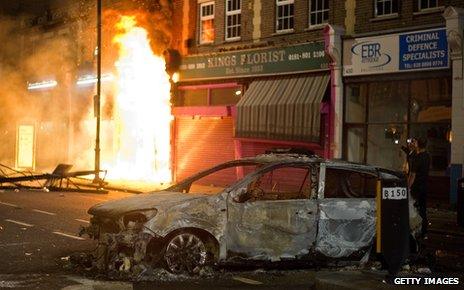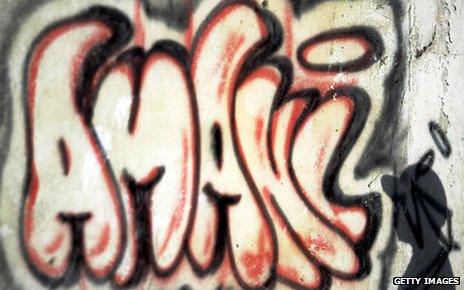Could babies' faces reduce crime?
- Published
Local babies' faces painted on London shop fronts
A host of conventional measures have been tried to control anti-social behaviour - CCTV, community policing, court orders, and tougher sentencing - but could paintings of babies and other offbeat techniques help?
A parade of shops in south-east London is the site for an experiment.
As evening draws in, the shop shutters along Greens End, a street in Woolwich, come down, revealing a gallery of portraits of local babies.
They were painted by a collective of graffiti artists, who worked from family photos sent in by people living close by.
The Greens End shops were badly damaged by looters in the riots of summer 2011. The mobile phone shop belonging to Zaffar Awan was among those attacked.
"We had another set of shutters. They were broken and almost everything was stolen from the shop," he says. He's one of the shop owners involved in the experiment.
Awan is delighted with the face of Max - the little boy, dressed in blue, whose smile now adorns his shop front outside business hours.
"It's been here about three weeks now," he says, "Most passers-by who see him smile. I wish we could keep the shutters down and open the shop at the same time. That would be ideal."
Tara Austin, of Ogilvy and Mather advertising agency, which paid for and initiated the scheme, points to a series of research papers, published as long ago as the 1940s, into the effect that seeing an image of a baby has on an adult stranger.
"The evidence suggests that babies' faces, the round cheeks and the big eyes, promote a caring response in human beings," she says.

Shops around the country were badly damaged during the riots
The experiment, named Babies of the Borough, follows other attempts to try and use the environment to moderate behaviour.
One that has had plenty of publicity is the controversial Mosquito Anti-Loitering Security Device. The gadget emits an unbearable buzzing sound and can be set to a pitch that is audible only to those under the age of 25.
It was initially used to prevent teenagers gathering outside shops, but opponents tried to get it banned as a breach of human rights.
Music has also been used. London Underground copied a successful scheme from Tyne and Wear's Metro system to use classical music to reduce crime, external.
It was claimed that there was a significant drop in some types of crime on the Metro after the introduction of Mozart, Beethoven and Bach in stations in 1997.
The theory - thought to have come from Montreal, Canada - is that youths who don't find the music too "uncool" to congregate will at least learn respect for their environment because the music gives it the aura of a museum or church.
In the town of Mansfield, in Nottinghamshire, pink lighting has been installed in areas where teenagers hang out. It's supposed to highlight their acne, so they're too embarrassed to be seen there. Cardiff too, has been experimenting with the same idea.
"These strategies are well worth trying," says Prof Mike Hardy, of Coventry University's Institute of Community Cohesion. "But would you really advocate the mass installation of pink lighting to promote community?"
He prefers preventative measures to stop disturbances happening in the first place.
"The massive engagement of communities in the clean-up after the 2011 riots was a more powerful phase than the riots themselves," he says.
Prof Carmine Pariante of the Institute of Psychiatry at King's College London has just published The London Riots: A Psychiatrist's Perspective.
"Driving adolescents away from an area, as with the mosquito device, protects the area, but it doesn't solve the problem," he says. "The difficulty that youth has is a lack of social belonging."
Hardy has been impressed by schemes in other countries designed to make sure that lack of social belonging never develops. He cites a graffiti wall in the Kenyan capital, Nairobi, where people are invited to paint whatever they want.

The Kenyan graffiti wall was regularly cleaned and returned to a blank canvas
"There's no pre-determined content. They can communicate anger, frustration or happiness," he says. "When it's full, it's wiped clean and the process starts again."
He also talks about a scheme in Singapore where young people are invited to send a text message to a dedicated number when they spot tension building within their peer group.
The number is monitored by a safety community councillor, who's ready to mediate when the alert is sounded.
"It's an early warning system. They don't wait for the police to produce CCTV pictures of a crime once it has happened. It's about anticipation rather than reaction," Hardy adds.
But will Greens End's baby-faced defence shield work? Austin plans to study crime figures in Woolwich to measure whether the idea is having the desired effect.
And even if the effect is not proven, many will still have enjoyed seeing the paintings.